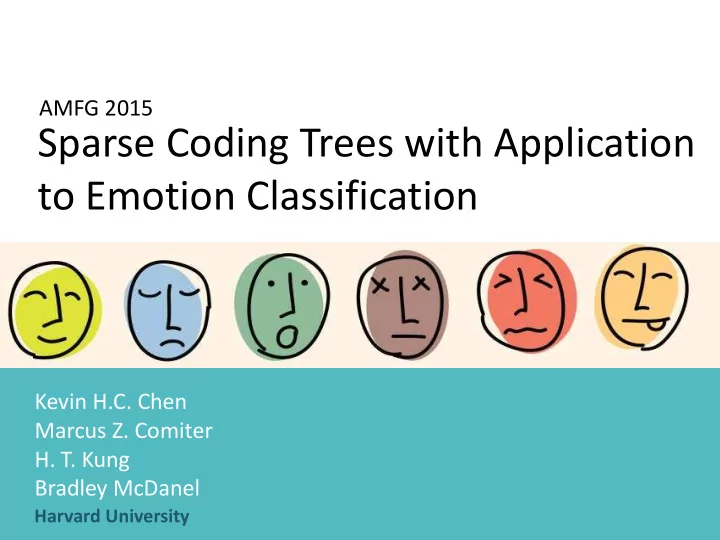

AMFG 2015 Sparse Coding Trees with Application to Emotion Classification Kevin H.C. Chen Marcus Z. Comiter H. T. Kung Bradley McDanel Harvard University
Application Motivation Emotion Classification for IoT and Beyond Business Applications Politics Medicine User feedback systems, Automatic derivation Additional metrics for advertising, security systems of voter preferences, patient care, helping children with autism focus group testing
Methodology Motivation Machine Learning and Unsupervised Feature Extraction - Sparse coding makes data more linearly separable Feature 2 - Labels are not required Feature 1
Sparse Coding Pipeline for Classification x Unsupervised Transform data into feature representation Sparse Coding z Supervised Prediction with simple Classifier (e.g., SVM) classifiers such as SVM label
Representation by Sparse Coding Express the input signal (x) as the weighted (z) sum of a few features (D) 2 argmin z | | x - Dz| | 2 + λ | | z| | 0 Note: we can also penalize L1 norm instead of L0 norm
Dictionary Learning - Finds common patterns in training data - Solved by alternating updates of D and Z 2 argmin D,Z | | X - DZ| | 2 + λ | | Z | | 0 Sparse Coefficients
Our Enhancement to SC Sparse Coding tree (SC-tree) to learn features with hierarchy Non-negative constraints to mitigate over-fitting in SC Mirroring to increase variation tolerance
Sparse Coding Tree Learning Features for Hard Cases - Some discriminating features can be subtle - Finding clusters within clusters, similar to how hierarchical k-means works Fear can be confused with happiness because they both display teeth
Constructing Sparse Coding Tree If certain classes get confused consistently, put them through another layer of feature extraction Input Sparse Coding Classifier (e.g., SVM) label Group/Label Assignment label label
Branching in Sparse Coding Tree Based on the confusion matrix from the coarse predictor surprise fear happiness anger contempt disgust sadness
Features Learned in SC-tree Features learned in the root node Input Could be happy or fear Features learned in a happy v.s. fear node label label label happy fear
Mirroring for Reflection Invariance Using max pooling to capture the horizontal symmetry inherent in emotion classification Sparse coding (LASSO/OMP) max split pooling Sparse coding (LASSO/OMP) flip A reflected image would get the exact same representation
Improved Robustness with Mirroring With max pooling, we always pick up response from the side of face with stronger features
Nonnegative Sparse Coding Nonnegativity prevents cancelation of components, and therefore mitigates over-fitting 2 argmin z | | x - Dz| | 2 + λ | | z| | 0 s.t. D ≥ 0, z ≥ 0 D with NN-constraint D without NN-constraint Tends to learn regional components
Datasets Multi-class Cohn-Kanade Extended Dataset (CK+) Multi-class Emotions in the Wild Dataset (EitW) Binary GENKI-4K Dataset Binary AM-FED Dataset AM-FED GENKI CK+ after pre-processing original data
Performance on Emotion Classification The sparse coding tree improves the performance of our pipeline consistently. 79.9 CK+ dataset 76.8 75.1 73.6 w/SC Tree 71.5 70.1 w/o SC Tree SC NNSC MNNSC Results reported in average recall
Performance on Emotion Classification The sparse coding tree improves the performance of our pipeline consistently. 33.0 EitW dataset 29.7 29.4 28.6 28.1 w/SC Tree 26.5 w/o SC Tree SC NNSC MNNSC Results reported in average recall
MNNSC Performance with Mirroring and the non-negativity constraint, even greedy methods like OMP (L0) can be competitive GENKI-4K AM-FED 97.0 96.7 96.2 best reported 92.3 92.1 96.1 91.2 95.7 95.1 best reported 89.7 Mirroring 90.0 88.8 Non-negativity 93.1 86.0 sparse coding L 0 -min L 1 -min L 0 -min L 1 -min Results reported in area under curve
Applying Sparse Coding Tree to Action Recognition Tested on KTH dataset with SC Tree 92.13 % 86.57 % without:
Conclusion Sparse coding, as an effective feature extraction method, can be enhanced by these techniques: Sparse Coding tree (SC-tree) to learn features with hierarchy Non-negative constraints to mitigate over-fitting in SC Mirroring to increase variation tolerance
Recommend
More recommend